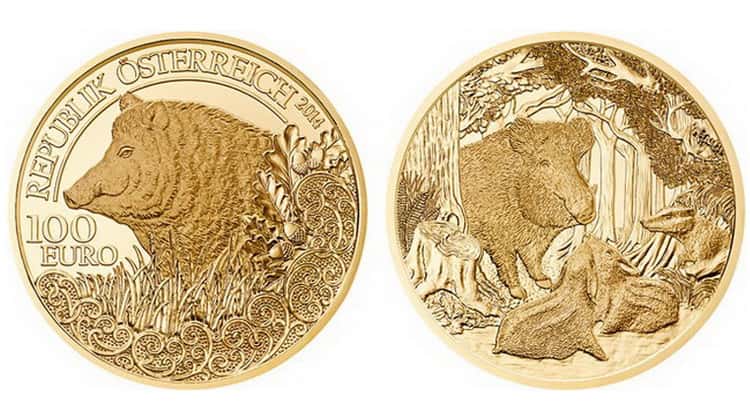
100 Austrian euros – collectible and bullion coins, which were produced exclusively from gold until 2016. The minting started in 2002 when Austria switched from shilling to euro. The only non-collectible coin with a face value of 100 euro is the Philharmoniker, although it is popular among numismatists. All coins of 100 euro denomination are not intended for payment. Collectible coins are issued in a limited circulation of 30,000. Only the copies issued after 2011 are not sold out completely. You can find all Austrian 100 Euro in our catalog of gold coins.
Austrian coins of 100 euro
Since 2002, the Austrian Mint has been issuing 100 euro coins with lots of different themes. The completed series are Crowns of the House of Habsburg, Viennese Art Nouveau, Art Treasures of Austria. The last sixth coin of the series “Wildlife in our Sights” will be issued in the second half of 2018. Also, platinum, gold and silver euros of Austria, dedicated to the Vienna Philharmonic, Philharmoniker are in demand among numismatists.
Art treasures of Austria
General specifications of the series
Production: Austrian Mint
Design: Herbert Weiner, Thomas Pesendorfer
Metal: gold (Au 986)
Weight: 16 g
Quality: Proof
Diameter: 30 mm
Edge: plain
Total circulation: 60,000; 30,000 of every type
Sculpture
Date of issue: 11.13.2002
Obverse: image of George Raphael Donner; the Belvedere Palace in the background; inscription “Republik Österreich”; face value “100 EURO”; name “Rafael Donner” at the bottom; year of minting “2002” to the right.

Reverse: image of the fountain Provendentia Brunnen by Georg Donner (Providentia, the divine embodiment of the ability to foresee in the ancient Roman religion is on a column in a center holding a medallion with a portrait of Janus, a two-faced god of beginning and end in her hands); inscription “Provendentia Brunnen” on both sides; elderly man, symbolizing the river Enns, the right tributary of the Danube, which flows through the federal land of Salzburg; child,symbolizing a smaller tributary of the Danube.

Painting
Date of issue: 11.5.2003
Obverse: Gustav Klimt near two easels with canvases; inscription “Republik Österreich” to the left; denomination “100 EURO” and year of issue “2003” at the bottom left; name of the coin designer “H.Wähner”; “Gustav Klimt” and years of his life “1862 1918” on the right.
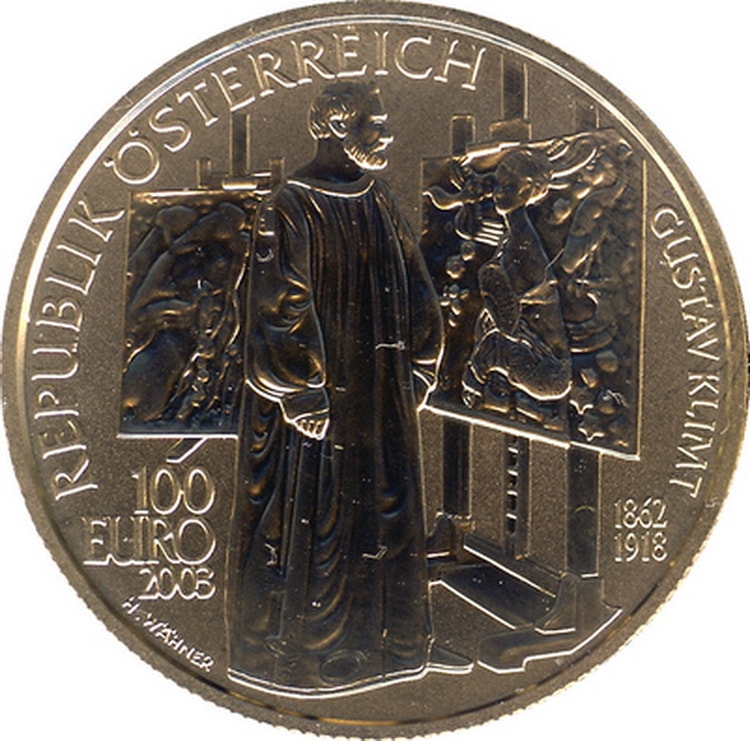
Reverse: image of “The Kiss”, written in 1908; inscription “Der Kuss” to the right.
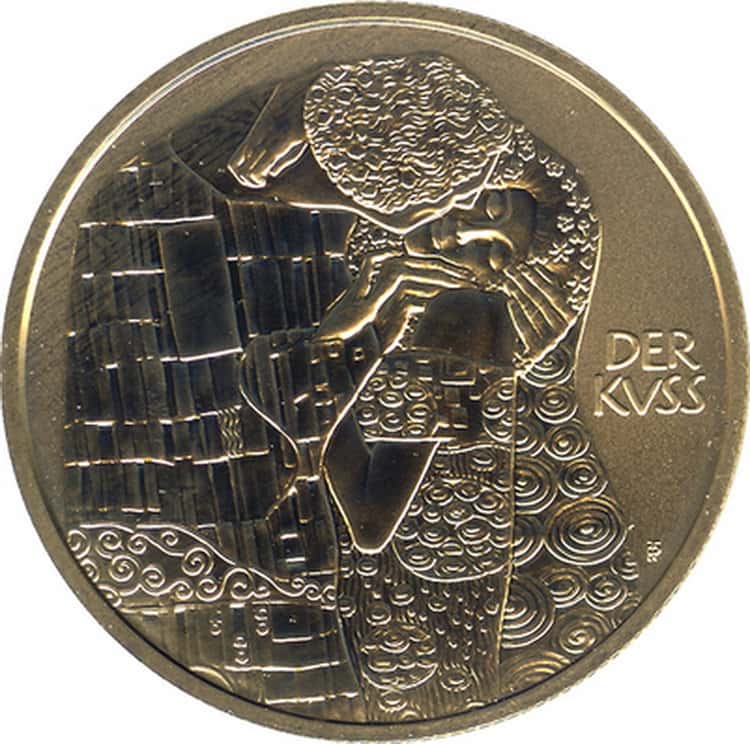
Viennese Art Nouveau (Jugendstil)
General specifications of the series
Production: Austrian Mint
Design: Helmut Andeckinger, Tomasz Pesendorfer
Metal: gold (Au 986)
Weight: 16 g
Quality: Proof
Diameter: 30 mm
Edge: plain
Total circulation: 120,000; 30,000 of every type.
Vienna Secession
Date of issue: 11.10.2004
Obverse: image of the Secession House, an exhibition hall built in 1897 by Josef Maria Olbrich as an architectural manifestation of the Vienna Art Nouveau; inscriptions “Ver Sacrum” and “Der ZeitihreKunst. Der KunstihreFreiheit»; “RepublikÖsterreich”; denomination “100 EURO” and year of minting “2004”.
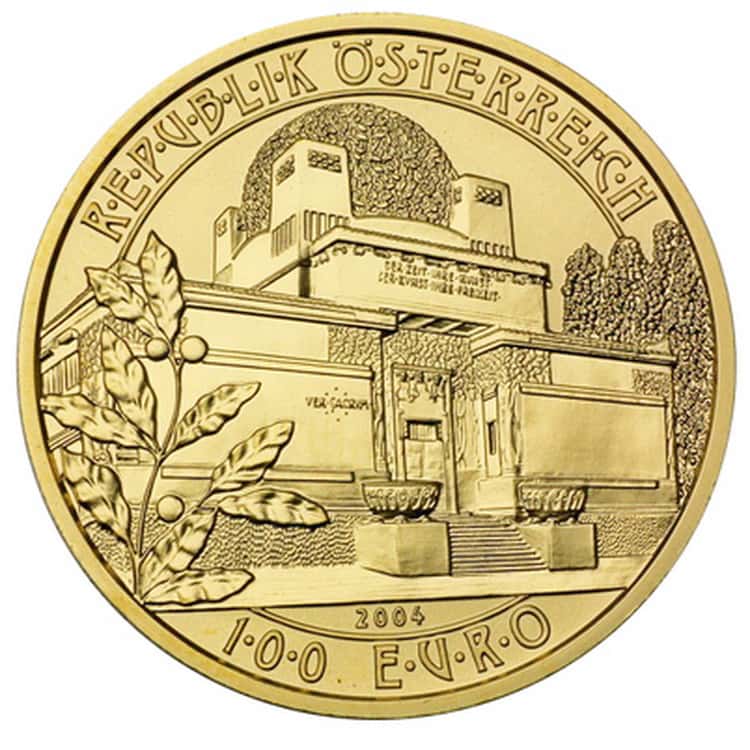
Reverse: fragment from Beethoven Frieze by Gustav Klimt, the part with a knight in armor, symbolizing the “Force” and two women: one of them holding the wreath – a symbol of victory, symbolizing “Ambition”, and other one standing with a bowed head and folded hands under her chin – “Sympathy”; inscription “Beethovenfries”.

Steinhof Church
Date of issue: 11.9.2005
Obverse: the Church of St. Leopold on the Steinhofhill; inscription “Kirche am Steinhof” between the statues; the engraving “Republik Österreich” at the top; year of minting “2005” and denomination “100 EURO” at the bottom.
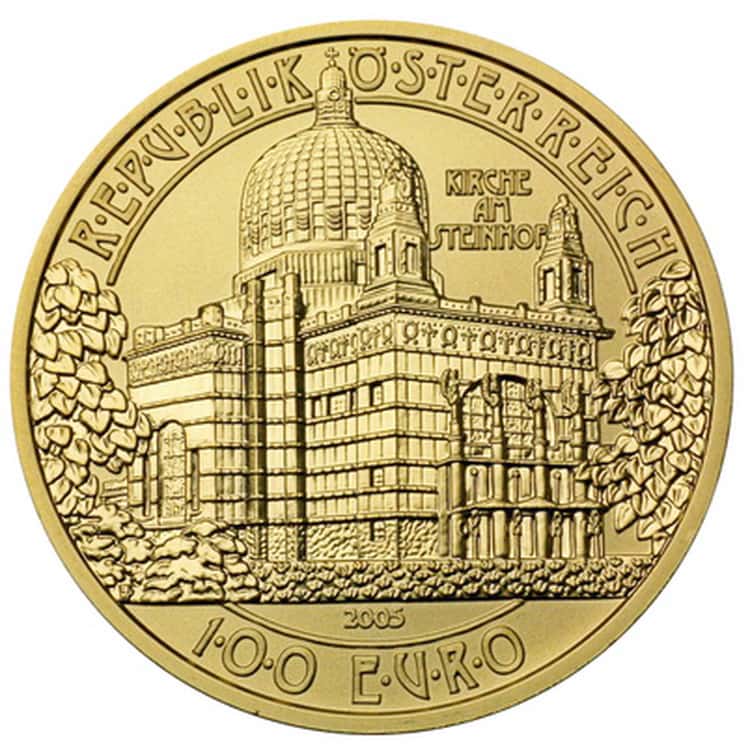
Reverse: part of the stained-glass window above the main entrance of the church by Koloman Moser, one of the founders of the Vienna Secession; in the center there’s God the Father seated on a throne with two bronze statues of the angels on both sides by Omar Shmitzkovichon.

Wien River Gate
Date of issue: 8.11.2006
Obverse: image of the River Gate, built in 1906 (portal part is made in the Viennese Art Nouveau style by Friedrich Ohmann and Josef Hackhofer; the coin was dedicated to the 100th anniversary of the construction in 2006); inscription «Wienfluss-Portal» above the tunnel; inscription «Republik Österreich» at the top; year of minting «2006» and denomination «100 EURO» at the very bottom.
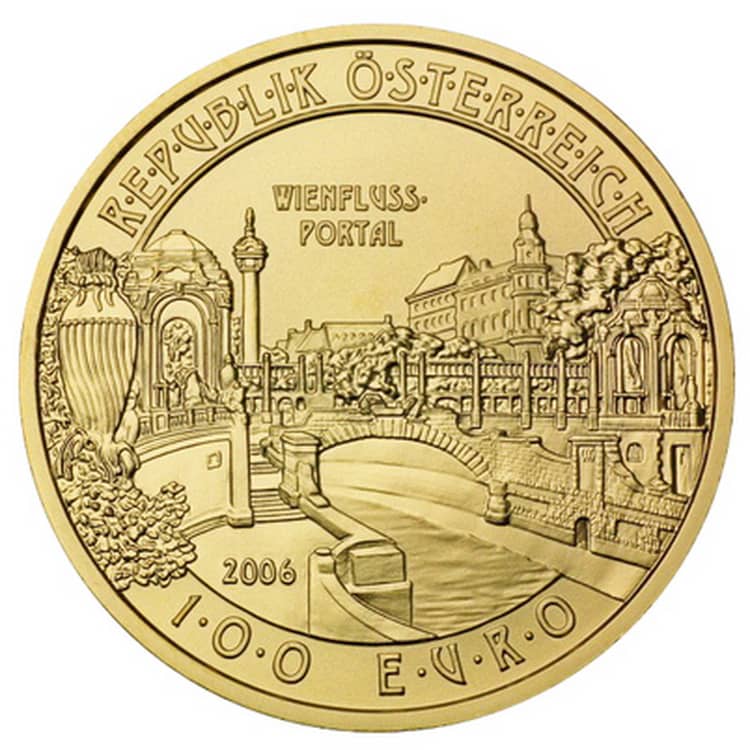
Reverse: statue of a woman at the entrance to the Vienna City Park. The Viennese river gate is one of the most beautiful buildings in the city, made in the style of the Viennese Art Nouveau.
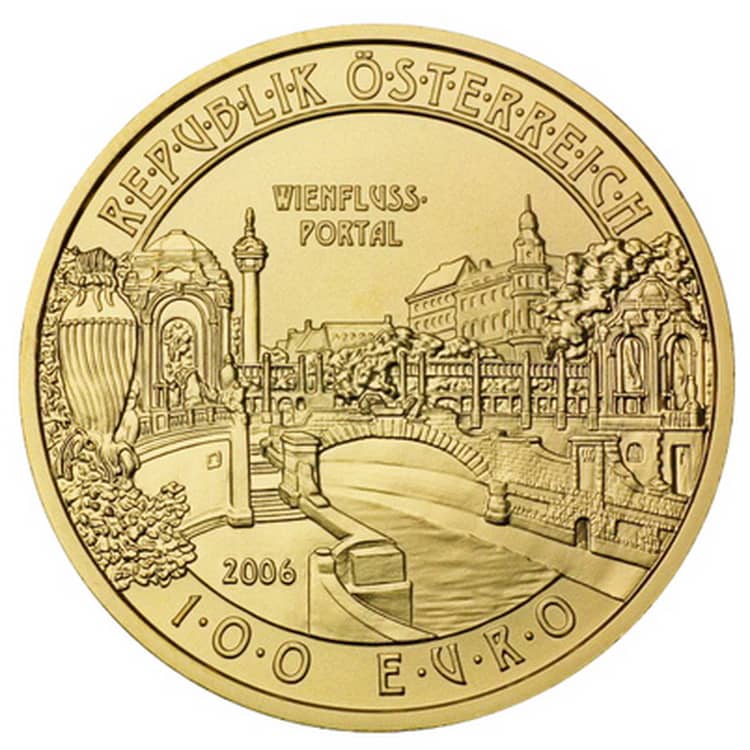
Vienna architecture (Linke Wienzeile Nr 38)
Date of issue: 7.11.2007
Obverse: building at Vienna, Linken Wienzeile Nr. 38 by Otto Koloman Wagner built in 1898 (it is famous for its corner design, gold facade ornaments by Koloman Moser, sculptures by Othmar Schimkowitz. Famous Viennese surrealist painter Wolfgang Paalen was born in this house); inscription “Haus Linke Wienzeile No. 38” on the front of the building on the first floor; inscription “Republik Österreich”, denomination “100 EURO” at the top; year of minting “2007” at the bottom.

Reverse: image of the staircase and elevator inside the house, the fence and iron gates made in the Viennese Art Nouveau style; gold medallion with a woman’s face on a flower pot to the left, one of Koloman Moser’s works.
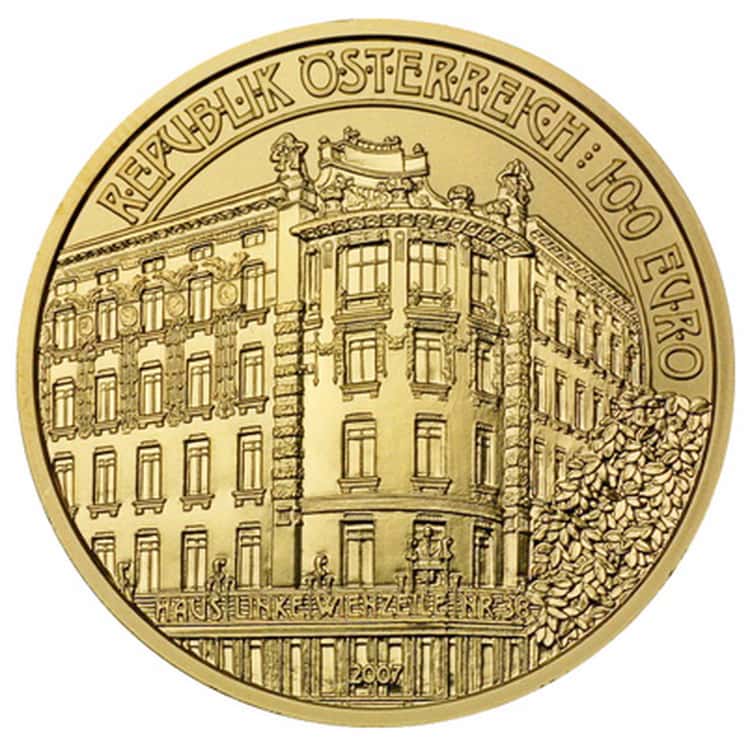
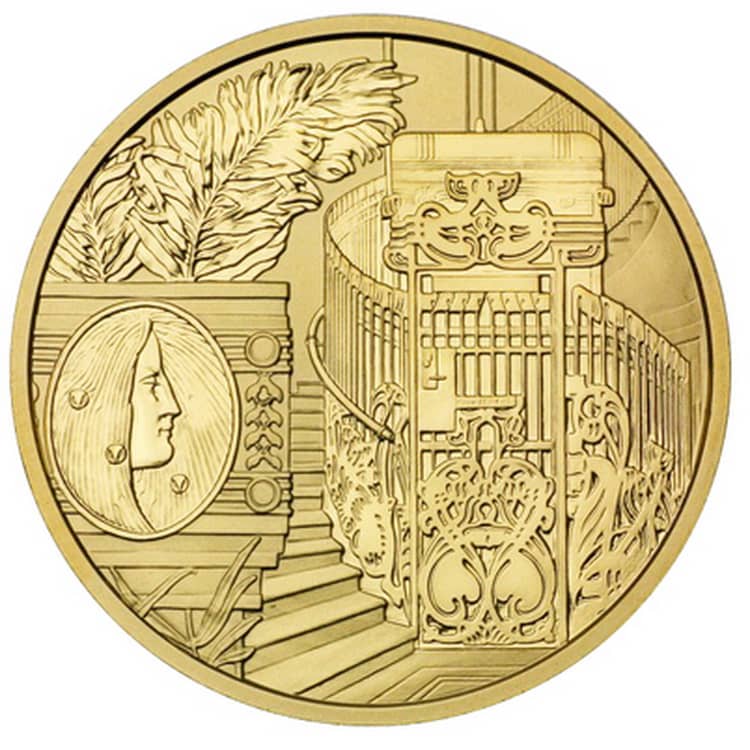
Crowns of the House of Habsburg series
General specifications of the series
Production: Austrian Mint
Design: Helmut Andeckinger, Thomas Pesendorfer
Metal: gold (Au 986)
Weight: 16 g
Quality: Proof
Diameter: 30 mm
Edge: plain
Total circulation: 150,000; 30,000 of every type.
The Crown of the Holy Roman Empire
Date of issue: 11.5.2008
Obverse: image of the octagonal crown made from gold and precious stones with which Otto I was crowned with the accession on the throne of the Holy Roman Empire in 962; inscription “Republik Österreich” above the crown, denomination “100 EURO” on the right; year of minting “2008” on the left, inscription “Krone des hl RömischenReiches” at the bottom.

Reverse: image of sitting Emperor Otto I; St. Peter’s Basilica in Rome in the background; inscription “OTTO I” under the cathedral symbolizes the recognition of the primacy of the Catholic Church over the emperor of the Holy Roman Empire.
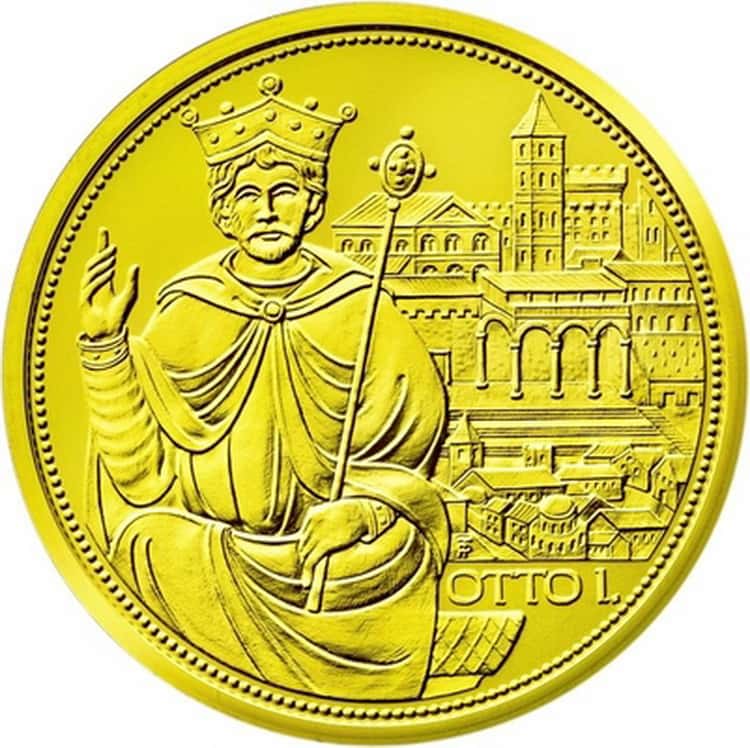
The Archducal Crown of Austria
Date of issue: 11.4.2009
Obverse: image of the crown of Archdukes of Austria, lying on a cushion; inscription «Republik Österreich» above the crown; denomination «100 EURO» to the left, year of minting «2009» under it; inscription «Österreichischererzherzogshut» at the bottom.
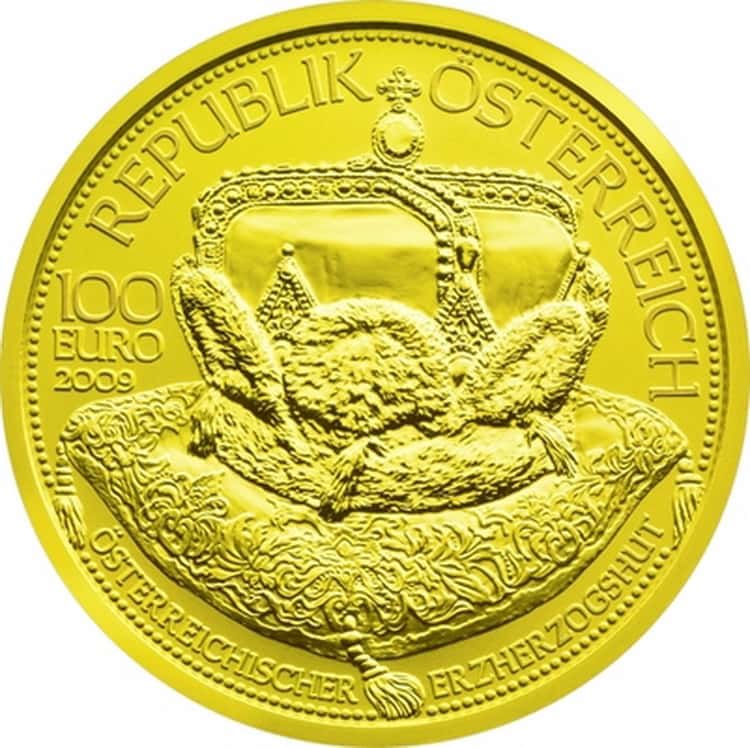
Reverse: image of the procession moving from the castle of Hofburg to the Cathedral of St. Stephen, carrying the regalia of the monarchic power: the crown, orb, and scepter for the coronation of the Archduke of Austria; inscription «ErbHuldigung».

The Hungarian Crown of St. Stephen
Date of issue: 11.10.2010
Obverse: image of the crown of St. Stephen, the prince of Nitra and the first King of Hungary, recognized as a saint for the Christianization of the Hungarians; inscription «Republik Österreich» above the crown; year of minting «2010» to the left; denomination «100 EURO» to the right; inscription «Stephanskrone» at the bottom.
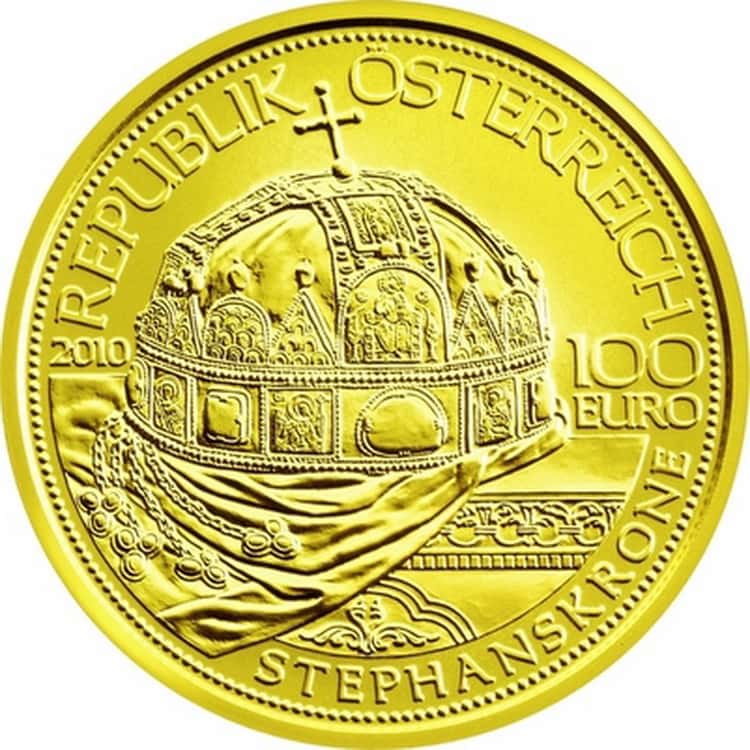
Reverse: image of Maria Theresa, Archduchess of Austria, riding on horseback on June 25, 1741, the day of her coronation on the Hungarian throne; the largest castle of Presburg Bratislava Castle in the background to the right; inscription «Maria Theresiakönigin von Ungarn» at the top.
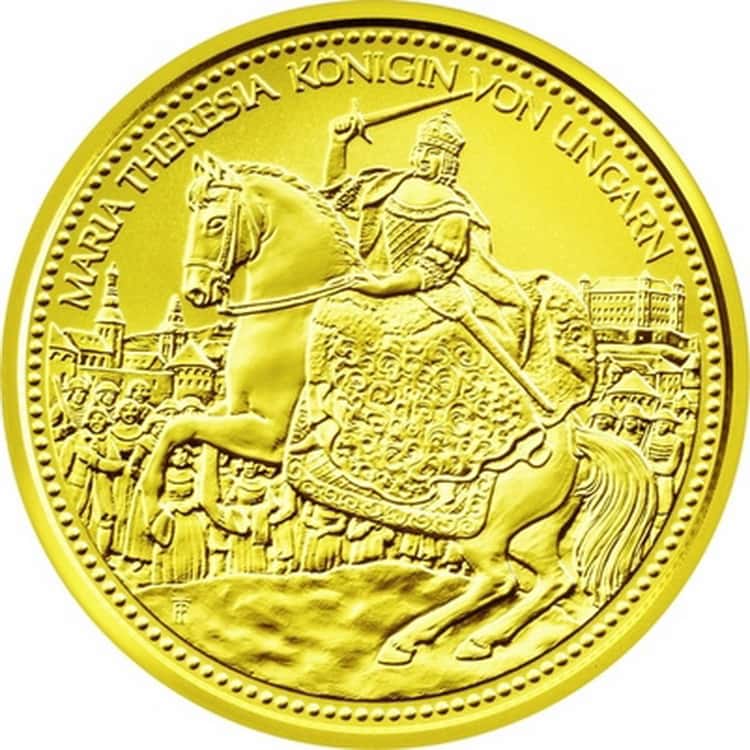
The Crown of St. Wenceslas
Date of issue: 9.11.2011
Obverse: image of the crown dedicated to St. Wenceslas, the Duke of Bohemia and patron of the Czechs (the crown was made in 1347 for the coronation of Charles IV of Luxembourg); the fabric under the crown is embroidered with the Czech coat of arms – white, two-tailed lion; inscription Republik Österreich above the crown; year of minting 2011 to the right; denomination 100 EURO to the left, inscription Wenzelskrone at the bottom.
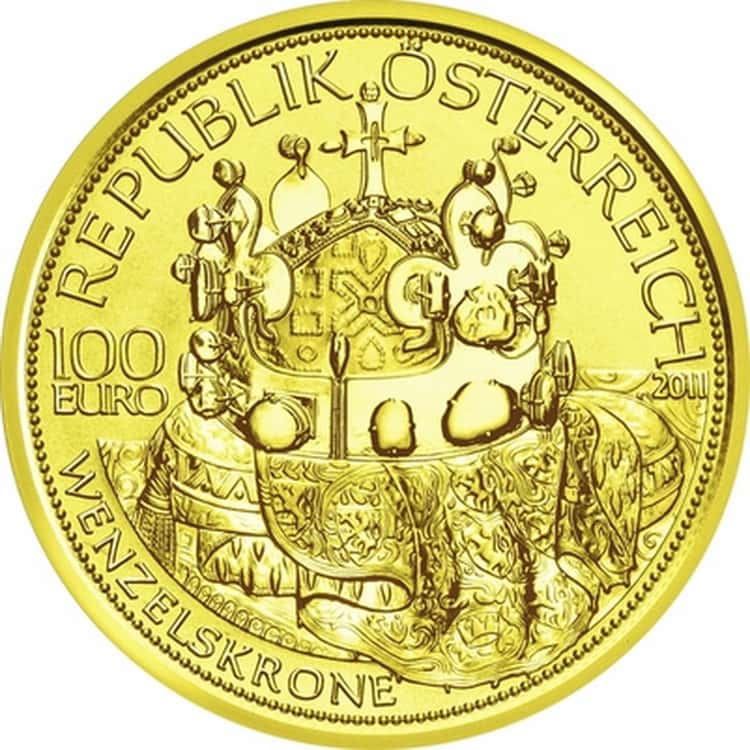
Reverse: image of Rudolph II, crowned on the throne of Bohemia in 1575; the Charles Bridge and the fortress of Prague Castle in the background the crown of St. Wenceslas is stored in the highest building of it, St. Vitus Cathedral); inscription Rudolfkönig v Böhmen at the bottom.
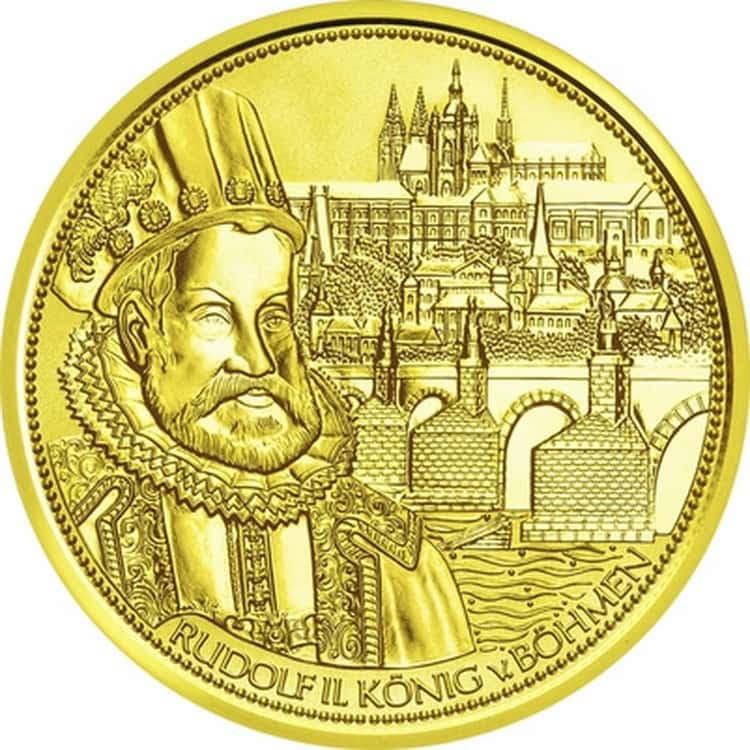
The Imperial Crown of Austria
Date of issue: 11.14.2012
Obverse: image of the crown of the Austrian Empire, lying on a pillow with tassels; inscription Republik Österreich; year of minting 2012 to the right; denomination 100 EURO to the left; inscription Die Österreichische Kaiserkrone at the bottom.
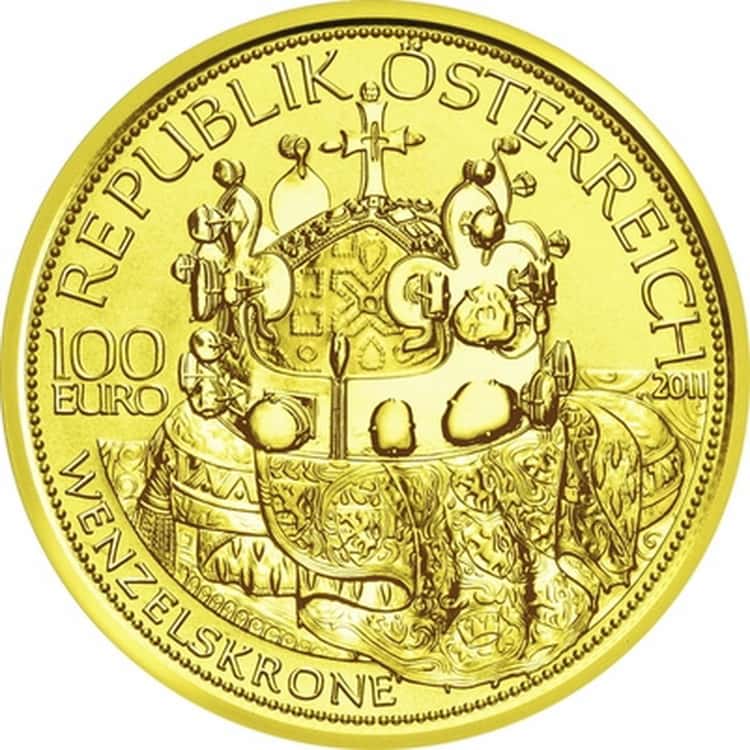
Reverse: image of Emperor Franz Joseph I in the imperial mantle with a scepter in his right hand; the crown of the Austrian Empire on the table; two-headed eagle – the coat of arms of the Austrian Empire in the background; inscription “Franz Joseph I”.

Wildlife in our sights
General specifications of the series
Production: Austrian Mint
Design: Helmut Andeckinger, Thomas Pesendorfer, Herbert Weiner, Catherine Kuntner
Metal: gold (Au 986)
Weight: 16 g
Quality: Proof
Diameter: 30 mm
Edge: plain
Total circulation: 150,000; 30,000 of every type.
The Red Deer
Date of issue: 10.30.2013
Obverse: roaring stag of the red deer in its natural habitat; inscription «Republik Österreich» at the top, year of minting «2013», denomination «100 EURO» to the right.
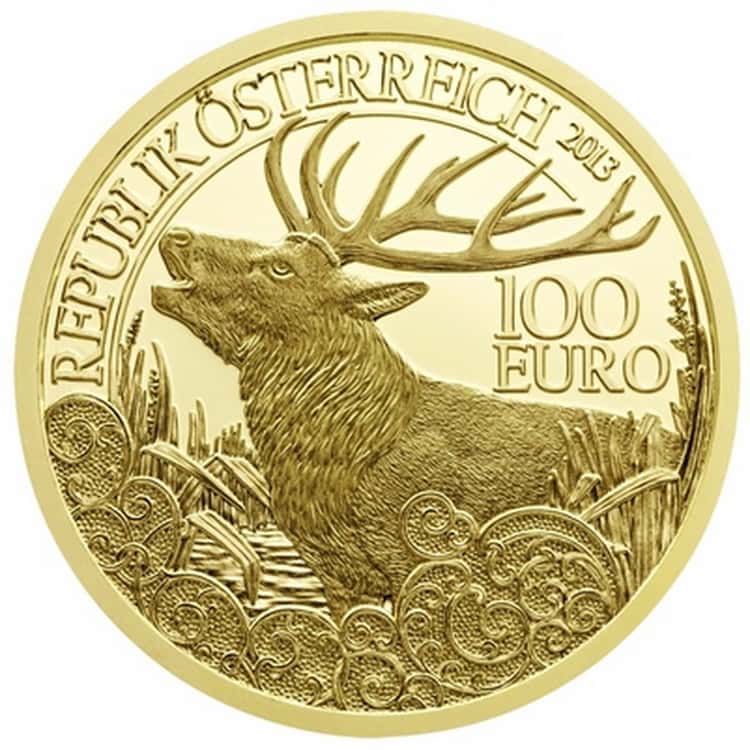
Reverse: male deer, guarding a female and a calf on the foreground of a dense forest and river.
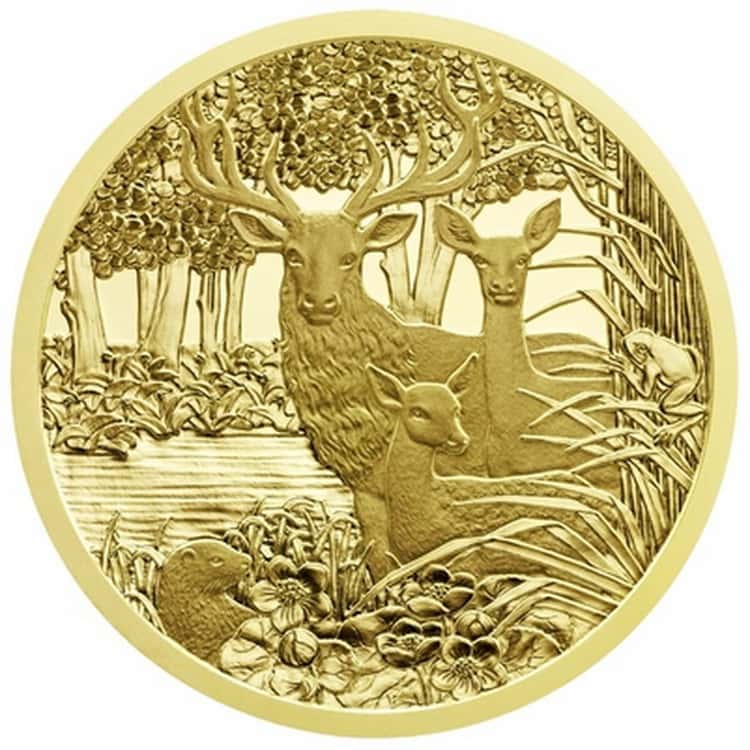
The Wild Boar
Date of issue: 10.29.2014
Obverse: male wild boar in profile, oak leaves and acorns engraved to the right, symbolizing favorite habitat, the oak forest and favorite food of the animal; inscription “Republik Österreich” and year of minting “2014”, denomination “100 EURO” on the right side.

Reverse: female wild boar watching the game of its brood in the mud; badger to the right of them.
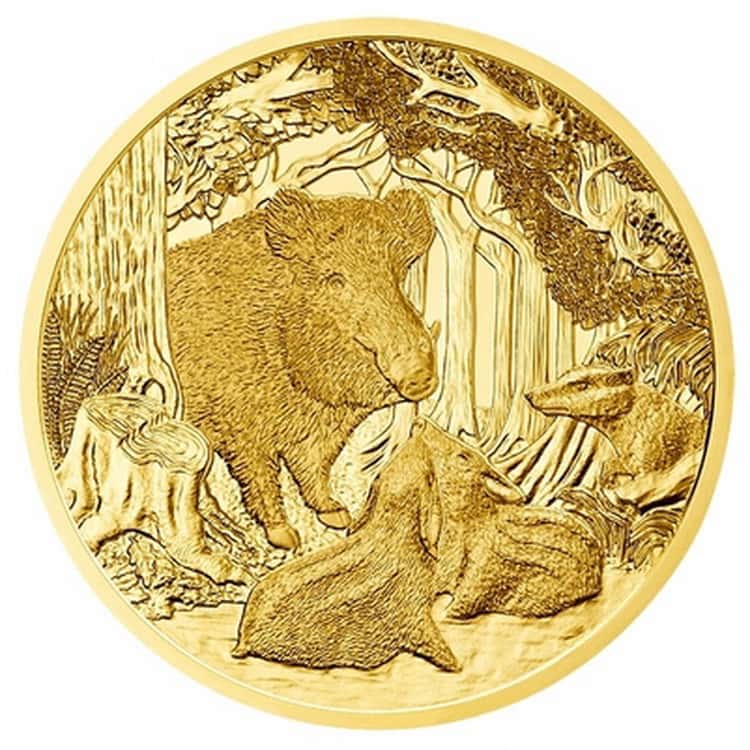
All Austrian gold coins in our catalog.
The Capercaillie
Date of issue: 10.28.2015
Obverse: male wood grouse; inscription «Republik Österreich» and year of minting «2015» to the right; denomination «100 EURO» to the left.
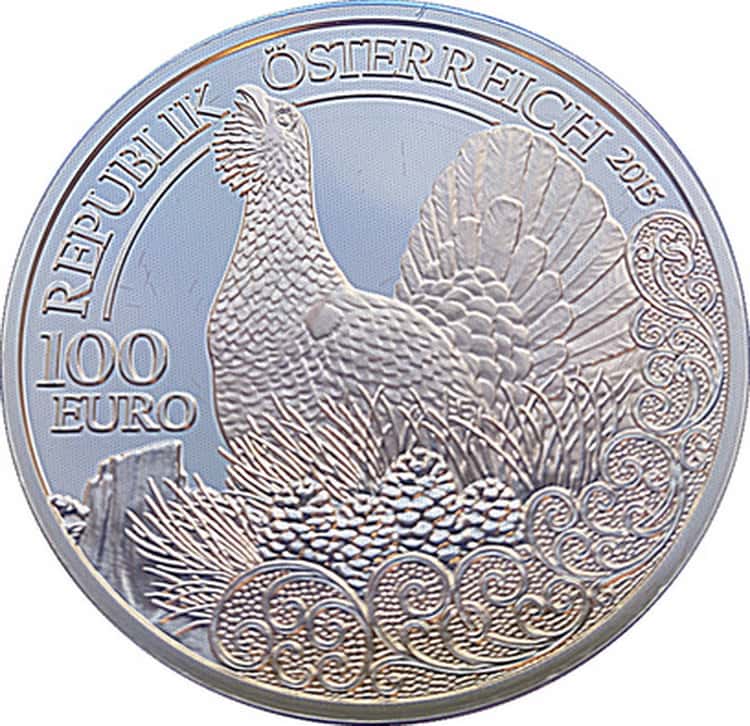
Reverse: male and female wood grouses, sitting on a tree branch; bird’s habitat in the background: a rocky area covered with coniferous forest.
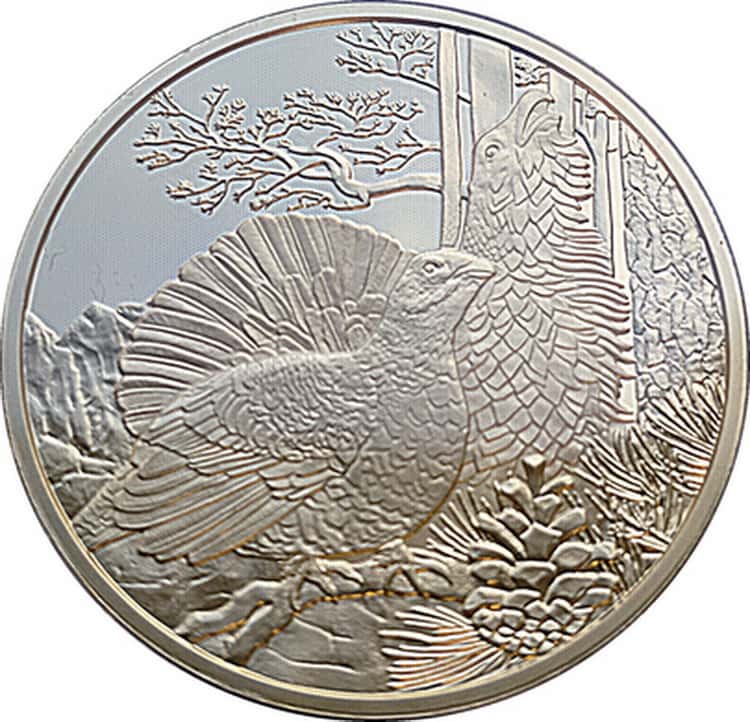
The Fox
Date of issue: 11.2.2016
Obverse: fox in tall grass (fox is an intelligent and unusually careful and bold animal; foxes live not only in forests and suburbs, but they also visit the outskirts of cities at night, live closer to a human than any other representative of wild fauna); inscription “Republik Österreich” and year of minting “2016” at the top; denomination “100 EURO” below it.
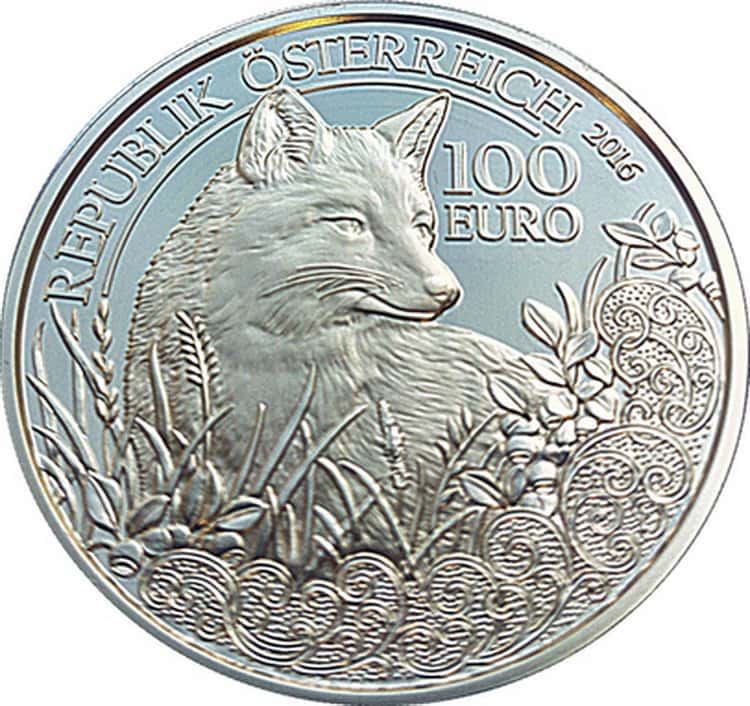
Reverse: fox with two cubs in the natural habitat, the barely discernible silhouette of the field mouse in tall grass in the lower part of the coin.
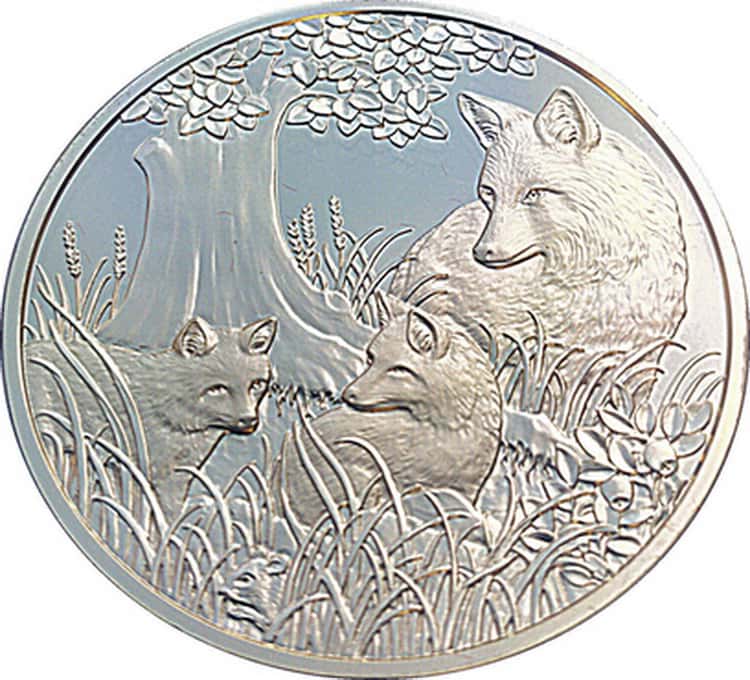
The Alpine Ibex
Date of issue: 18.10.2017
Obverse: Alpine ibex in profile surrounded by primroses and edelweiss; mountain in the background; inscription «Republik Österreich» and year of minting «2017» at the top; denomination «100 EURO» close the center.
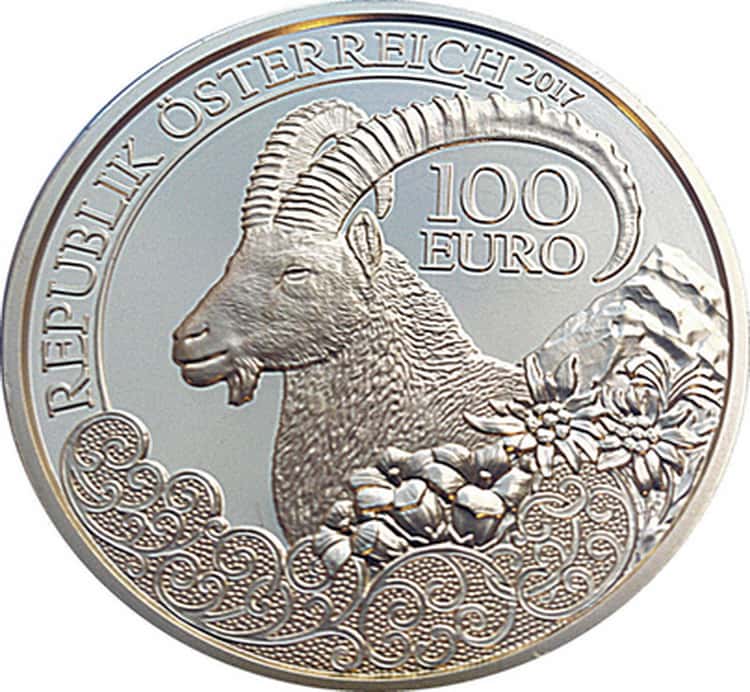
Reverse: image of an ibex and its young on a steep mountain slope; marmot near the Edelweiss in the lower part of the coin.
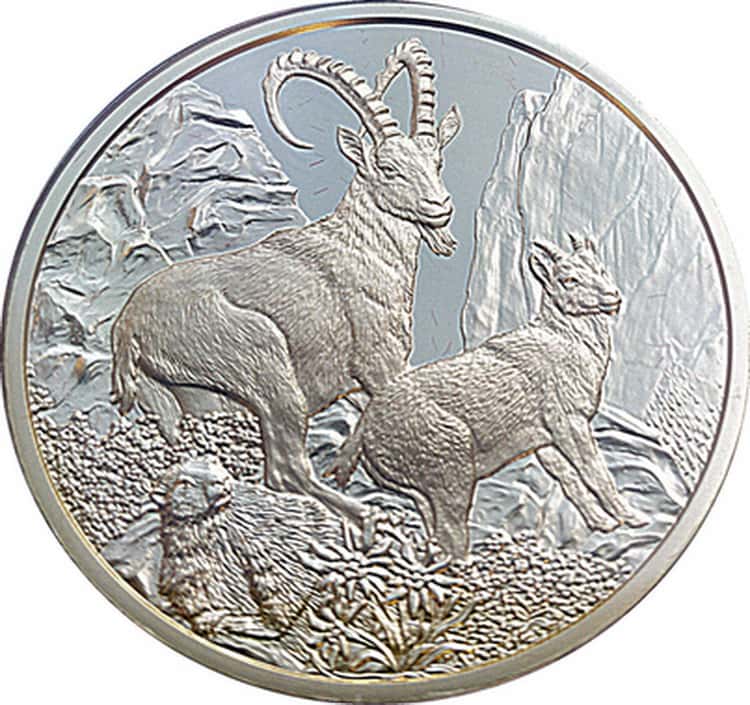
All Austrian silver coins in our catalog.
Vienna Philharmonic
Golden Philharmonikers, very popular among collectors, are issued in different denominations, including 100 euro.
Specifications of the Gold Philharmoniker
Production: Austrian Mint
Design: Thomas Pesendorfer
Metal: gold (Au 999)
Weight: 31.11 g
Diameter: 37 mm
Thickness: 2 mm
| Edge: reeded |
| Year of issue | Circulation |
| 2002 | 164,105 |
| 2003 | 179,881 |
| 2004 | 176,319 |
| 2005 | 158,564 |
| 2006 | 82,174 |
| 2007 | 108,675 |
| 2008 | 715,800 |
| 2009 | 903,047 |
| 2010 | 501,951 |
| 2011 | 586,686 |
| 2012 | 341,411 |
| 2013 | 579,223 |
| 2014 | 418,919 |
| 2015 | 647,100 |
| 2016 | 451,007 |
Obverse: musical instruments of the Vienna Philharmonic Orchestra: horn, bassoon, harp, four violins, cello; inscription «Wiener Philharmoniker».
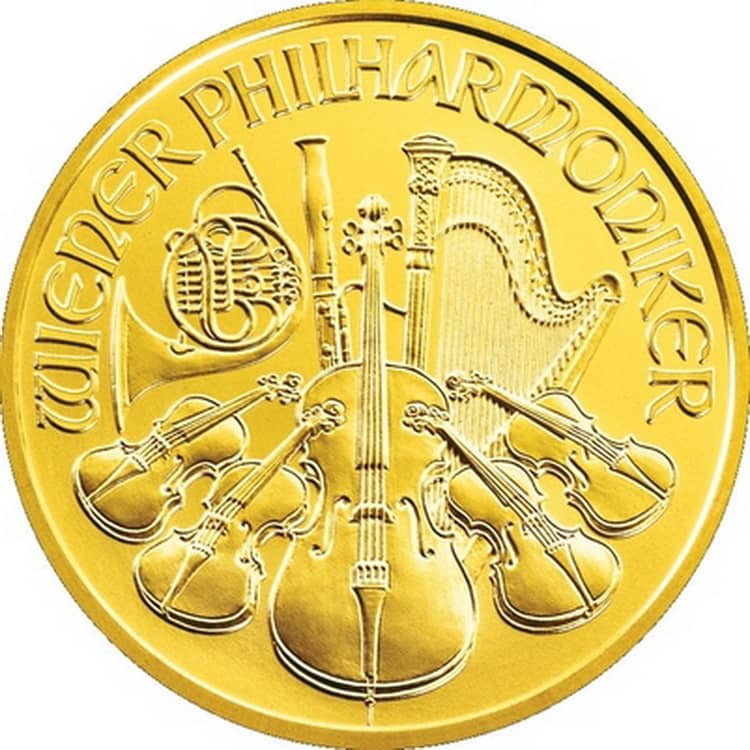
Reverse: pipe organ from the Gold Hall of the Vienna Philharmonic set in 1907 by the Rieger Orgelbaufirm as a replacement for the original one created by Friedrich Ladegast; inscription «Republik Österreich» above it; «1 UNZE GOLD 999.9» below it; year of minting and denomination «100 EURO» at the bottom.
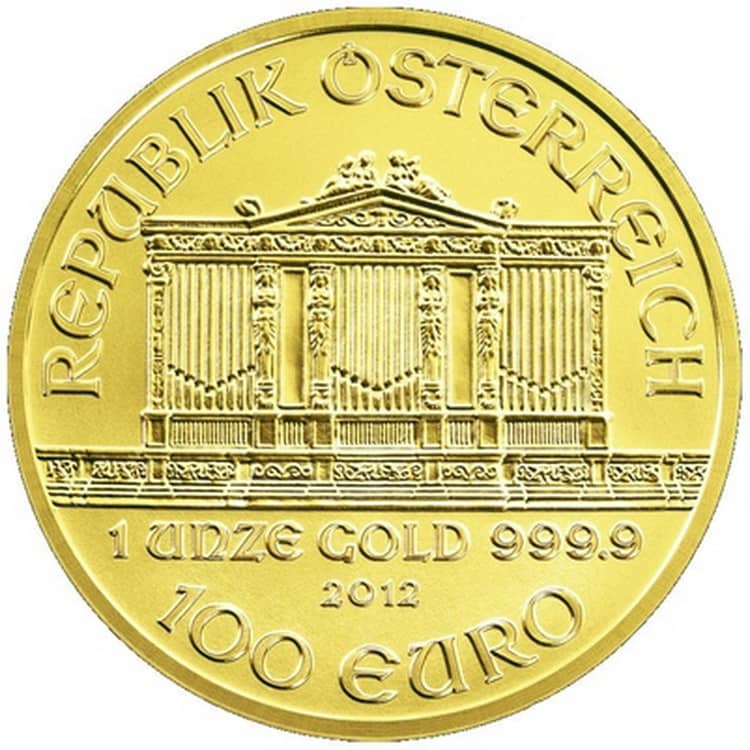
Specifications of the Platinum Philharmoniker
Production: Austrian Mint
Design: Thomas Pesendorfer
Metal: platinum (Pl 999.5)
Weight: 31.11 g
Diameter: 37 mm
Thickness: 2 mm
Edge: reeded
Circulation in 2016: 35,257.
Obverse: identical to the Gold Philharmoniker, with the only difference – inscription «PLATIN».
Reverse: difference of the platinum philharmonic from gold one is the inscription «1 UNZE PLATIN 999.5» instead of «1 UNZE GOLD 999.9».

Cost of the coins
The price of coins from the sold-out series, even given their small age, grew by about 5%. This is related both to the material of production – gold, which provides a stable value of the coin, small circulation of these coins, and high-grade engraving from the masters of the Austrian mint. Investing in high-quality collectible coins made from a material that does not lose value for thousands of years is at least break-even, and given that coins have already grown in price, it can be assumed that the price will continue to grow.
Interesting facts
- The world-famous chief designer of the Austrian Mint and the creator of the Philharmoniker, Thomas Pesendorfer, retired in 2016. The master, who received numerous awards during his life, considers engraving not simply a craft but an “art”. The Wildlife in our sights series was “the last painting of the artist”.
- It takes master-engraver up to 1 year to create a plaster standard of the coin. Then the template is scanned, and a high-precision engraving machine with an error of 0.001 mm mints the coins from the blanks.
- The Austrian Mint is famous for the highest quality of raw materials and minting. It is not disclosed which countries order minted coins, but it is known that the blanks for coins are exported to 35 other mints around the world
- A free Coin club is organized for the customers of the Austrian Mint. In addition to 4 annual magazine issues, the club members receive special offers, invitations to mint events, and discounts from numerous partner companies.
Comments
No commens yet.